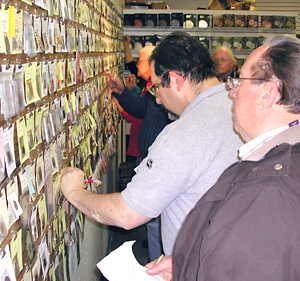|
"Making Cents"
The Signal
Saturday, January 27, 2007
| U |
Twenty years ago, there were many more coin shops than there are today, and most of them had a bid board. The prototypical bid board was the giant, 2,500-lot board hosted by Doyle's Coin Palace in Buena Park. It was operated for some 20 years in the 1960s-80s. The retail shop took over an adjacent store and used three of the walls for the bid board.
As with most others of its type, the bid board — a "silent auction," as it's known in non-numismatic circles such as charity fundraisers — was open to bidders and consignors who could buy and sell coins in this manner. The store kept 10 percent of the sale proceeds.
The mechanics of a bid board consist of the bid card, usually with a section for bidders to enter their registered bid number and their bid. At a specific time, such as 8 p.m. every Friday, a bell will ring and all bidding will stop. The last bid entered on each lot wins the lot. Lots with no bids are separated from those with bids and are returned to the consignors.
The night of the closing, the successful lots are tallied up, and if the bidders are present, their lots are reconciled at the time. Some bidders prefer to return during the week when the business is less frenetic.
On some Friday evenings, there could be more than 200 people in the shop because of a run of exciting items on the board. Most lots will have a minimum bid (aka "reserve" price) posted. Those with "open" bids (no reserve) usually see the most activity.
Some years ago, I had purchased several dollars' worth of used silver quarters, sorted through the coins and pulled out the ones with above-average potential — that is, worth more than the 15 to 20 times their face value at the time. One such find was a scarce 1896-S Barber quarter in Fair to About Good grade. With no reserve or minimum bid posted, it went for a generous $65. There were 20 bids entered from eager buyers.
In another case, I had purchased a lot of low-grade 19th-century coins from a dealer at the Queen Mary Coin Show. In the lot were some worn, bent, and damaged 3-cent silver pieces. I put five of them on a bid board as one lot. When I checked the following week, I saw an amazing final bid of $230. Apparently three of the coins were rare issues of the 1860s. I hadn't even bothered to check the dates and expected perhaps $5 for the lot.
Marvin Shear, the owner of the shop with the bid board, moved to smaller quarters when the coin market slowed down and had a smaller board at the newer location.
During this period, I frequented the bid boards of several other Southern California coin shops, all with a similar pattern. Once in a great while, I would succeed in finding a high-quality item I wanted. More often than not, I would consign various items for sale. I found this method more suitable than advertising the coins in the media.
Since the rise in the past decade of eBay and other online auction sites, such as Teletrade, many bid boards have closed down, as sellers find the competition for quality and unusual coins to be much stronger on the World Wide Web than on a local coin shop bid board. However, for less expensive items — generally under $50 — the local coin shop bid board survives and still serves a need.
Mid Valley Coin Co. in Granada Hills is one such example, having been in operation for more than 25 years on Chatsworth Street. A much smaller scale than Doyle's, it still draws several dozen bidders every Friday, and about half of all lots find a new home after the closing bell rings.
Dr. Sol Taylor of Sherman Oaks is president of the Society of Lincoln Cent Collectors and author of The Standard Guide to the Lincoln Cent. Click here for ordering information.
©2007, THE SIGNAL · ALL RIGHTS RESERVED.

![[Most Recent Quotes from www.kitco.com]](http://www.kitconet.com/images/quotes_special.gif)

